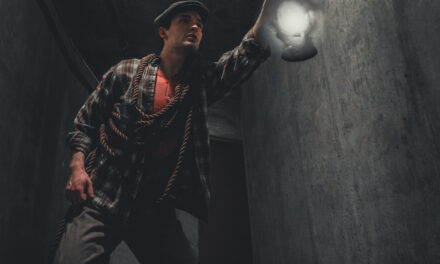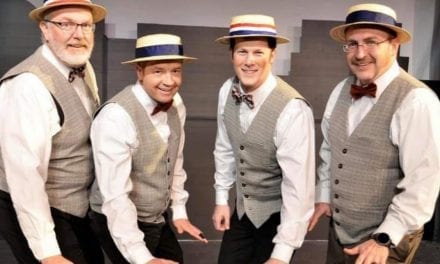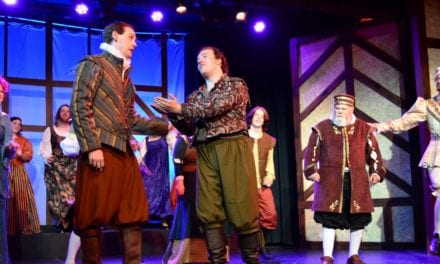DRAPER — My greatest love for theatre is its ability to teach us and possibly even change us. The Draper Arts Council production of Footloose has succeeded, because even with its upbeat 1980’s music, dancing, and general high school melodrama, it still teaches and changes us. This production was successful in my opinion because of a clear focus of the director on the most important message being told and the creation of community within the show and the audience.
It took me a while to reach this conclusion. In fact, for first act I thought the production was poorly done on many aspects of the show. What was recognizable, even in my overly strict judgment to that point, was the show’s ability to create community. This was apparent from our arrival to the Draper Amphitheater, nestled amidst a subdivision on South Mountain. It was clear all those involved in the box office and concessions were excited to be involved in the production. My five total trips to the concessions stand was enthusiastically greeted by the workers like an old friend with an inside joke. Similarly, the audience was building community as I found several friends in attendance, and it seemed that many others had as well.
In the production, director and choreographer Susan DeMill found excellent ways to utilize of 70 adults, teenagers, and children. I particularly enjoyed the short choreography segments which included the children as means to detract from the scene change, which was helpful when the bright sunlight and no closed curtain left little to the imagination. And in scenes such as “The Girl Gets Around” and “I Can’t Stand Still”—where some other productions of Footloose that I’ve seen had only the actors with lines on stage—it was nice to see a community involvement and reaction to these songs that can clearly have an effect on them.
However, as I said, during the first act there were many things I had difficulty with. The large scene for “Somebody’s Eyes” stood out the most for me. The song presents a montage of Ren’s experiences depicting his difficulty in adapting from living in Chicago to Bomont’s small town way of life. However, it often felt like some of the cast didn’t know how to act on stage when they didn’t have lines, or know how the choreography of the townspeople was reinforcing the song. I also had trouble finding the lead singers among all the cast on stage, despite their strong voices. Some faulty microphones played into this, but these were not my primary concern.
 This type of commentary ran through my head during Act 1, making it hard for me to fully enjoy the production. When I explained this to my wife, she was surprised. She liked it just the way it was. She also reminded me that a community theater production I acted in last year had similar problems and that I should keep the standards of amateur theatre in mind as I judged the show. I was taken aback for a moment and then realized she was right, as usual. The second act then became a far more enjoyable experience for me.
This type of commentary ran through my head during Act 1, making it hard for me to fully enjoy the production. When I explained this to my wife, she was surprised. She liked it just the way it was. She also reminded me that a community theater production I acted in last year had similar problems and that I should keep the standards of amateur theatre in mind as I judged the show. I was taken aback for a moment and then realized she was right, as usual. The second act then became a far more enjoyable experience for me.
One major reason for this change was Demill pulling together all the elements she wanted to come across as described in her director’s note. This is a story about people dealing with various personal issues—from Ren’s father leaving him for no clear reason to the effects of the death of Bobby Moore, the son of Reverend and Vi Moore and Ariel’s only brother. Ren and his mother come to town and find out that this death resulted in a tribute law outlawing dancing and anything else that could be construed as corrupting. While Ren tries to repeal the law, he, Reverend Moore, and many others begin to realize that it isn’t about dancing and the fight over it really helps resolve their own issues.
This happens in one great scene after another. Rusty (Rachel Perry) helps her love, Willard (Jonathon Cooper) to realize he can dance (sort of) and she loves him exactly how he is. It is a truly hilarious experience as he breaks out of his shell and dances in the flatbed of a truck while Rusty strongly belts to the girls, “Let’s Hear It for the Boy.” My personal choice for strongest performance went to Carrie Wrigley as Vi Moore. She really exhibited all the complication in dealing with the loss of her son, her husband’s resulting detachment, and Ariel’s rebellion. She had a strong clear voice and always held the attention required for a strong woman trying to help her family and those around her.
A constant joy throughout the show was Jonathon Cooper as Williard, who did such a good job of making me laugh all the way through his “Mama’s Says” as he imparts his mother’s bizarre wisdom. (After all, if you hadn’t thought of using a “toaster in the shower,” now you know it’s a bad idea.) Ren (Jake Taylor) and Ariel (EmmaLee Bodell) really shined when they prepare for and sang “Almost Paradise.” They nailed this song both musically and in the buildup. As sung by Taylor and Bodell, it is not just a corny love song, but rather a culmination of all their hopes that love might help them overcome their problems.
These problems are all resolved through the change of heart in Reverend Moore (Mike Weaver), which Demill definitely made clear in the climatic final scenes. Under Demill’s direction, Ren, Reverend Moore, Vi, and Ariel were all able to find reconciliation. The interaction between Rev. Moore and Ren where everything finally came out completely shattered any prior feelings I had of poor acting. The characters felt this, and those watching this scene did, too. Healing from pain was finally achieved for these characters.
Of course, now that the pain is gone, it’s time to celebrate. The finale to the song of Footloose brought together all the elements again. It was full of energy, brought in the whole community again, and had some great choreography that was fun to watch. I left the show truly enjoying the experience. I had once again learned something about solving the issues that clutter our lives, and that especially once you have that figured out, then it’s time to “Cut Footloose.”





